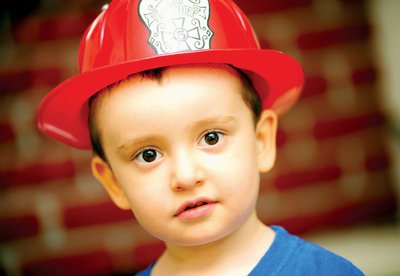Ty Murray, 3, holds his arms out like Buzz Lightyear from
the
”
Toy Story
”
series as he does the character’s famous line,
”
To infinity and beyond.
”
Ty Murray, 3, holds his arms out like Buzz Lightyear from the “Toy Story” series as he does the character’s famous line, “To infinity and beyond.”
He jumps on his dad’s back and giggles when his mom hugs him.
His dark eyes light up as he hands plates of plastic food to guests at his grandparents’ house in Hollister, where they watch him a couple of days a week while his parents work.
Ty’s parents, though, keep a close eye on the little boy from Gilroy who has been in and out of hospitals since he was 16 months old.
Diagnosed with Stage 4 neuroblastoma, Ty now goes to New York once a month as part of his treatment.
The illness is a rare type of childhood cancer that is mostly diagnosed in toddlers. About 650 children are diagnosed with neuroblastoma each year, according to the American Cancer Society.
“He’s thriving and running around,” said Carmen Hernandez Murray, Ty’s mother. “To look at him, you wouldn’t know he had cancer. He’s a normal 3-year-old who likes to play, but he is so used to the hospital.”
Since the diagnosis, Ty has undergone an aggressive treatment plan. He has endured radiation, high-dose chemotherapy, a stem-cell transplant and is now part of a clinical trial at Memorial Sloan-Kettering Cancer Center in New York.
Ty’s cancer is in remission, doctors said there was no evidence of the cancer in April, but his parents are still hopefully cautious.
“One of the other kids just relapsed after 20 months,” Carmen said. “We saw him two weeks before and he was fine. You couldn’t tell.”
Carmen mentioned another boy who went through the stem-cell transplant with Ty and had no evidence of the disease. He died in July.
“We’ve met so many families. We know so many kids who have died,” she said.
Carmen and Scott Murray, Ty’s father, share the story of how they were blindsided by his serious diagnosis.
“He had no symptoms, just low-grade fevers,” Carmen said. “He was fussy, but I was a new mom. I took him to the pediatrician and they said he is just colicky.”
Scott added the doctors thought the fever was related to teething. He took his son to the doctor for the second time in a week when the little boy would only lay on his dad’s chest and didn’t want to play.
“The doctor did notice his stomach was distended,” Scott said.
The doctor sent the family for an X-ray and then to the emergency room because they thought he had an enlarged liver.
“Later on, they said he had a tumor,” Scott said. “They showed us it had a 90 percent survival rate, and that was devastating.”
With further testing, the doctors discovered Ty had neuroblastoma, a type of cancer of the sympathetic nervous system.
“Research tells you there is a 20- to 30-percent survival rate,” Scott said. “It turns your life upside down. The only important thing is to get him healthy.”
Carmen remembers vividly getting the news of her son’s diagnosis at Stanford Hospital.
“I remember all these words and just saying neuroblastoma. It was heartbreaking. You would never think cancer,” she said.
When he was first diagnosed, he had a port implanted in his chest. A port is a plastic tube used in chemotherapy that is put into a chest or arm which allows medicines to be given or blood taken away from a vein.
Carmen and Scott found themselves overwhelmed with all the medical terms and procedures. They had to learn how to keep Ty’s port clean and to keep it from getting infected. He now has a different port installed under the skin, so he can swim and bathe without all the preparation.
The first year of treatment was especially hard.
“We had to keep him isolated the first year because he was going through chemo every month, so his immune system was down,” Carmen said.
Looking at Ty now, Scott recalled that same time.
“There was a … period where he didn’t want to acknowledge or look at anyone,” Scott said. “He was just miserable.”
Scott added the doctors said most adults could not survive the treatment.
“Throughout this whole process, he’s handled things well,” Scott said. “The nurses say he is the best patient because he knows the routines, but that is kind of sad that most of his life has been in and out of the hospital.”
His latest treatment, a clinical trial that uses an antibody to attack the neuroblastoma cells, brings the family to New York once a month for a week. The trial continues through May 2011.
“It’s just something you have to do,” Carmen said. “It’s not even a question. We are going and we will do whatever it takes to get him there. We are pros at flying with a toddler.”
Carmen said Ty looks forward to the trips to New York, despite his time in the hospital. He likes seeing friends he’s made at the hospital. He dons a blue New York Yankees cap, shading his dark brown eyes and covering his short, dark hair. His dad said he likes New York pizza.
Carmen and Scott work for the Santa Clara County probation department where their employers have been flexible about their time off. Carmen took a year off when Ty was first diagnosed and now works part time so she can get Ty to local appointments.
“We’ve been 10 times since February or March (2009),” Scott said, of traveling to New York. “It’s never been a problem. They’ve been really understanding.”
Their family has also been supportive. Scott’s father, who lives in Northern California, stays at their Gilroy residence when the family goes to New York. His mother and brother, who live in the Bay Area, come down to visit. Carmen’s family watches Ty when they have to work and she said her siblings have offered emotional support for her.
The Make a Wish Foundation has also helped. In October, Ty has been granted a trip to Disney World from the organization.
“We’ll probably go to Sea World then, too,” Carmen said.
When asked what keeps them optimistic, the couple has a long list.
“I can’t imagine doing it without the support,” Scott said.
“We joke about things still,” Carmen added. “You have to have a sense of humor. My faith in God has strengthened, if you can believe that.”
As for Ty, he seemed oblivious that anything is wrong as he jumped around the front lawn of his grandparents’ house, in his Yankees cap and a blue T-shirt with the words “Beat Cancer” on it.
***
What is neuroblastoma?
– Neuroblastoma is a form of cancer that starts in some types of primitive nerve cells found in embryos and fetuses. The tumors start in the sympathetic nervous system.
– Neuroblasts are a normal part of the sympathetic nervous system, but sometimes the cells do not mature fully before a baby is born. In most cases, the cells will continue to grow and mature into nerve cells or disappear. But in some children, the cells continue to divide and grow into neuroblastoma due to a DNA mutation acquired early in the child’s development.
– The average age of children who are diagnosed with neuroblastoma is 1 to 2 years of age. Almost 90 percent of cases are diagnosed by age 5.
– It accounts for about 7 percent of all cancers in children, and about 650 new cases are diagnosed in the United States each year.
– The most common symptom is an unusual lump or mass, usually found in a child’s abdomen. The child may not want to eat or complain of feeling full or having pain.















